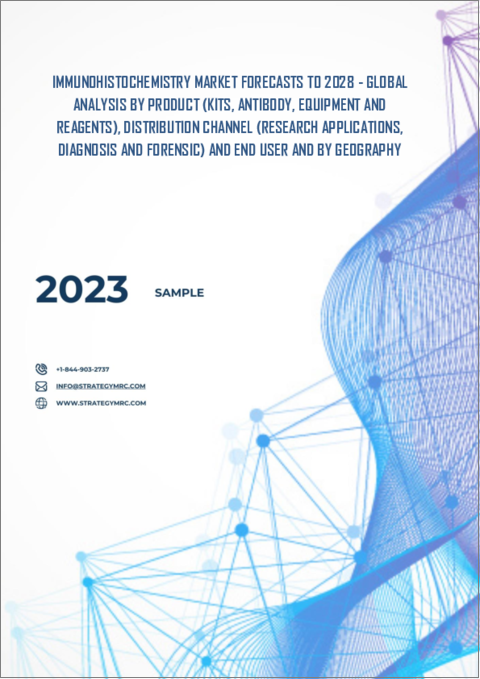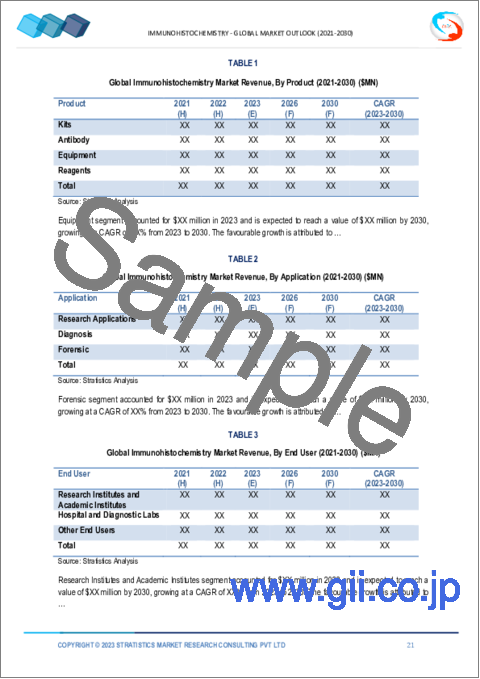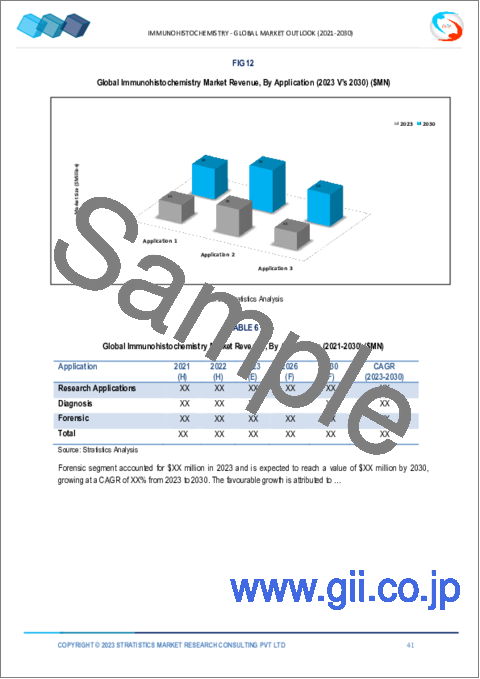|
|
市場調査レポート
商品コード
1284274
免疫組織染色(IHC)市場の2028年までの予測- 製品別(キット、抗体、装置、試薬)、用途別(研究用途、診断・法医学)、エンドユーザー別、地域別の世界分析Immunohistochemistry Market Forecasts to 2028 - Global Analysis By Product (Kits, Antibody, Equipment and Reagents), Distribution channel (Research Applications, Diagnosis and Forensic) and End User and By Geography |
||||||
カスタマイズ可能
|
|||||||
| 免疫組織染色(IHC)市場の2028年までの予測- 製品別(キット、抗体、装置、試薬)、用途別(研究用途、診断・法医学)、エンドユーザー別、地域別の世界分析 |
|
出版日: 2023年06月01日
発行: Stratistics Market Research Consulting
ページ情報: 英文 175+ Pages
納期: 2~3営業日
|
- 全表示
- 概要
- 図表
- 目次
Stratistics MRCによると、免疫組織染色(IHC)の世界市場は2022年に26億米ドルを占め、2028年には42億4,000万米ドルに達すると予測され、予測期間中にCAGR8.5%の成長を遂げる見込みです。
免疫組織染色(IHC)は、バイオマーカー開発に不可欠です。免疫組織染色(IHC)は、抗原や高分子細胞成分の同定に用いられる顕微鏡検査法です。様々な細胞タイプ、生物学的サイクル、さらには複雑な組織内の細胞内における標的タンパク質の存在と局在を可視化する必要があります。最近のIHCの進歩には、1つのサンプルで多数のタンパク質を高感度に検出することや、タンパク質間の相互作用を簡単に検出することが含まれます。この技術は、薬剤の検査や様々な病気の診断に利用することができます。
世界保健機関(WHO)のファクトシート、2022年2月によると、がんは世界の主要な死因であり、2020年の死亡者数は約1000万人、つまり死亡者数のほぼ6人に1人を占めるとされています。
市場力学:
促進要因
老年人口の増加
世界の老人人口の急増に伴い、加齢関連疾患の有病率は飛躍的に上昇すると予想されます。老年人口は、世界の他の先進国でも多く、増加しています。感染症を発症する確率は、加齢に比例して高くなります。その結果、高齢者人口の増加に伴い、さまざまな疾患の有病率が国際的に上昇することが予想されます。これは、診断用免疫組織染色(IHC)市場の重要な推進力であると考えられています。
抑制要因
統合の度合いが高い
抗体特許の期限切れは、世界市場にとって大きな問題です。メルク社(ドイツ)とF.ホフマン・ラ・ロシュ社(スイス)の一次抗体の一部は、特許保護を失おうとしています。さらに、市場参入企業は、世界各国の政府からの価格圧力の高まりや研究開発成果の減少などの課題に対処しなければなりません。こうした障壁を克服するために、著名なマーケットリーダーは、独自の特許製品を持つ中小企業を買収しています。これにより、これらの製品が新たな世界市場に参入するための巨大な財務・流通基盤が提供されます。
市場機会:
新製品の発売
主な市場開拓者は、現在のニーズに対応した技術開発に注力し、業界の発展を後押しします。先に述べた問題に対処するための新しい免疫組織染色(IHC)製品の発売により、市場は成長すると予想されます。トップ企業は最先端の商品を生産しており、市場拡大の原動力となることが期待されます。これらの臨床診断マーカーのイントロダクションは、イムノオンコロジーにおけるがん治療のための初期段階の薬剤開発を進めるのに役立つかもしれないです。研究開発の活発化により、予測期間中、市場は急速に成長すると思われます。
脅威
熟練した専門家の不足
がんの蔓延が進むにつれて、臨床応用のための病理学的サービスの需要も増加しています。がん患者に対して行われる検査の大半は、病理組織学技術を使用して行われます。しかし、これらの検査室では、訓練を受けた人材が不足しています。相当数の病理組織医が定年を迎え、限られた数の病理組織医が新たに育成されているに過ぎないです。一方、検査室は限られた人員で、増え続ける検体を処理する必要に迫られています。
COVID-19の影響:
COVID-19の発生は、免疫組織染色(IHC)市場に好影響を与えました。これは、世界中でCOVID-19感染の有病率が上昇し、COVI-19感染の検出のための免疫組織染色(IHC)技術の使用率が上昇したためです。例えば、Laboratory Investigation誌に掲載された2020年7月の論文によると、SARS-CoV-2の検出には免疫組織染色(IHC)およびin situ hybridization(ISH)技術が採用されています。すべての検体がIHCおよびISH陽性であったのに対し、COVID-19以外の患者さんの検体はすべてIHCおよびISH陰性でした。その結果、コロナウイルス(COVID-19)パンデミックの影響は、世界の免疫組織染色(IHC)市場にとってプラスに働いています。
予測期間中、抗体分野が最大となる見込み
抗体分野は、疾病診断や薬物検査における抗体の重要な利用により、有利な成長を遂げると推定されます。モノクローナル抗体およびFc融合体、抗体フラグメント、抗体薬物複合体などの抗体関連商品は、使用率において他のすべての製品クラスを凌駕しています。抗体は病理学、神経病理学、血液病理学など様々な用途で使用されています。また、創薬のための研究用抗体の利用が増加していることも、抗体市場の開拓を促進する大きな要因となっています。
診断分野は予測期間中に最も高いCAGRを示すと予想される
診断分野は、予測期間中に最も高いCAGRの成長を遂げると予測されています。免疫組織染色(IHC)検査は、自己免疫疾患、がん、感染症、心血管疾患、糖尿病、腎臓病など、さまざまな慢性疾患の診断に使用することができます。さらに、慢性疾患の有病率の増加は、診断薬業界を活性化すると期待されています。また、感染症が多いことや、IHC検査に対する有利な償還環境も、このセグメントの市場シェア拡大を後押しする要因となっています。
最もシェアが高い地域
予測期間中、北米が最大の市場シェアを占めると予測されます。北米地域の優位性は、診断センターや研究所でこの免疫組織染色(IHC)装置の使用が増加していることに起因すると考えられます。さらに、米国やカナダなどの国では魅力的な償還規制があり、自動化装置の使用を奨励しているため、北米地域におけるIHC市場の成長を後押ししています。さらに、北米諸国のがん患者数の増加により、こうした免疫組織染色(IHC)的アプローチのニーズが高まると予想されます。
CAGRが最も高い地域:
予測期間中、アジア太平洋地域が最も高いCAGRを示すと予測されています。アジア太平洋地域の免疫組織染色(IHC)市場の急成長は、インド、中国、韓国、シンガポールなどの国々の経済的繁栄に起因しています。さらに、インドや中国などの国々には多くの患者がおり、IHC研究開発試験の対象となる臨床被験者の数が多いため、収益の増加につながりました。さらに、慢性疾患の有病率の高さと人口の急速な高齢化も、アジア太平洋地域の免疫組織染色(IHC)産業の成長を促進する2つの要因となっています。
主な発展:
2021年8月、ロシュは、MMR経路が欠損している固形腫瘍に対する免疫組織染色(IHC)に基づくVENTANA MMR RxDxコンパニオン診断検査のFDA承認を得た。この検査は、GSK社の抗PD1免疫療法「JEMPERLI」の適応患者を特定します。
2021年8月、アジレントは、KEYTRUDAによる治療の対象となる食道がん患者を特定するためのPD-L1 IHC 22C3 pharmDxアッセイについて、欧州でCE-IVDマークを取得しました。
当レポートが提供するもの
- 地域レベルおよび国レベルセグメントにおける市場シェア評価
- 新規参入企業への戦略的提言
- 2020年、2021年、2022年、2025年、2028年の市場データを網羅
- 市場動向(促進要因、抑制要因、機会、脅威、課題、投資機会、推奨事項)
- 市場推定に基づく、主要ビジネスセグメントにおける戦略的提言
- 主要な共通トレンドをマッピングした競合情勢。
- 詳細な戦略、財務、最近の開発状況を含む企業プロファイル
- 最新の技術的進歩をマッピングしたサプライチェーン動向
無料のカスタマイズ提供:
本レポートをご購入いただいたお客様には、以下の無料カスタマイズオプションのいずれかを提供させていただきます:
- 企業プロファイル
- 追加市場プレイヤーの包括的なプロファイリング(最大3社まで)
- 主要プレイヤーのSWOT分析(3社まで)
- 地域別セグメンテーション
- お客様のご希望に応じて、主要国の市場推計・予測・CAGR(注:フィージビリティチェックによる。)
- 競合ベンチマーキング
- 製品ポートフォリオ、地域的プレゼンス、戦略的提携に基づく主要プレイヤーのベンチマーキング
目次
第1章 エグゼクティブサマリー
第2章 序文
- 概要
- ステークホルダー
- 調査範囲
- 調査手法
- データマイニング
- データ分析
- データ検証
- 調査アプローチ
- 調査ソース
- 1次調査ソース
- 2次調査ソース
- 仮定
第3章 市場動向分析
- 促進要因
- 抑制要因
- 機会
- 脅威
- 製品分析
- アプリケーション分析
- エンドユーザー分析
- 新興市場
- 新型コロナウイルス感染症(COVID-19)の影響
第4章 ポーターのファイブフォース分析
- 供給企業の交渉力
- 買い手の交渉力
- 代替品の脅威
- 新規参入業者の脅威
- 競争企業間の敵対関係
第5章 世界の免疫組織染色(IHC)市場:製品別
- キット
- ヒト組織用 IHCキット
- 動物組織用 IHCキット
- 抗体
- 一次抗体
- 二次抗体
- 装置
- 組織処理システム
- スライドスキャナ
- スライド染色システム
- その他の設備
- 試薬
- タンパク質分解酵素
- 有機溶剤
- 発色基質
- 希釈剤
- 組織学的染色
- 固定試薬
- ブロッキング血清と試薬
- その他の試薬
第6章 世界の免疫組織染色(IHC)市場:用途別
- 調査用途
- 薬物検査
- その他の調査用途
- 診断
- 自己免疫疾患
- がん
- 感染症
- 腎臓疾患
- 神経疾患
- その他の診断
- 法医学
第7章 世界の免疫組織染色(IHC)市場:エンドユーザー別
- 調査機関および学術機関
- 病院と診断研究所
- その他のエンドユーザー
- 製薬会社およびバイオ製薬会社
- 法医学研究所
- CRO
第8章 世界の免疫組織染色(IHC)市場:地域別
- 北米
- 米国
- カナダ
- メキシコ
- 欧州
- ドイツ
- 英国
- イタリア
- フランス
- スペイン
- その他欧州
- アジア太平洋地域
- 日本
- 中国
- インド
- オーストラリア
- ニュージーランド
- 韓国
- その他アジア太平洋地域
- 南米
- アルゼンチン
- ブラジル
- チリ
- その他南米
- 中東とアフリカ
- サウジアラビア
- アラブ首長国連邦
- カタール
- 南アフリカ
- その他中東とアフリカ
第9章 主な発展
- 契約、パートナーシップ、コラボレーション、合弁事業
- 買収と合併
- 新製品の発売
- 事業拡大
- その他の主要戦略
第10章 会社概要
- Agilent Technologies, Inc.
- Abcam plc.
- Bio SB
- Bio-Rad Laboratories, Inc.
- Cell Signaling Technology, Inc.
- Danaher Corporation
- F. Hoffmann-La Roche Ltd.
- Merck KGaA
- Perkinelmer, Inc.
- F hoffman La Roche
- Eagle Biosciences, Inc.
- CANDOR Bioscience GmbH
- Elabscience, Inc.
- Thermofischer Scientific Inc
- Biogenex Laboratories
List of Tables
- Table 1 Global Immunohistochemistry Market Outlook, By Region (2020-2028) ($MN)
- Table 2 Global Immunohistochemistry Market Outlook, By Product (2020-2028) ($MN)
- Table 3 Global Immunohistochemistry Market Outlook, By Kits (2020-2028) ($MN)
- Table 4 Global Immunohistochemistry Market Outlook, By IHC Kits for Human Tissue (2020-2028) ($MN)
- Table 5 Global Immunohistochemistry Market Outlook, By IHC Kits for Animal Tissue (2020-2028) ($MN)
- Table 6 Global Immunohistochemistry Market Outlook, By Antibody (2020-2028) ($MN)
- Table 7 Global Immunohistochemistry Market Outlook, By Primary Antibodies (2020-2028) ($MN)
- Table 8 Global Immunohistochemistry Market Outlook, By Secondary Antibodies (2020-2028) ($MN)
- Table 9 Global Immunohistochemistry Market Outlook, By Equipment (2020-2028) ($MN)
- Table 10 Global Immunohistochemistry Market Outlook, By Tissue Processing Systems (2020-2028) ($MN)
- Table 11 Global Immunohistochemistry Market Outlook, By Slide Scanners (2020-2028) ($MN)
- Table 12 Global Immunohistochemistry Market Outlook, By Slide staining Systems (2020-2028) ($MN)
- Table 13 Global Immunohistochemistry Market Outlook, By Other Equipments (2020-2028) ($MN)
- Table 14 Global Immunohistochemistry Market Outlook, By Reagents (2020-2028) ($MN)
- Table 15 Global Immunohistochemistry Market Outlook, By Proteolytic Enzymes (2020-2028) ($MN)
- Table 16 Global Immunohistochemistry Market Outlook, By Organic Solvents (2020-2028) ($MN)
- Table 17 Global Immunohistochemistry Market Outlook, By Chromogenic Substrates (2020-2028) ($MN)
- Table 18 Global Immunohistochemistry Market Outlook, By Diluents (2020-2028) ($MN)
- Table 19 Global Immunohistochemistry Market Outlook, By Histological Stains (2020-2028) ($MN)
- Table 20 Global Immunohistochemistry Market Outlook, By Fixation Reagents (2020-2028) ($MN)
- Table 21 Global Immunohistochemistry Market Outlook, By Blocking Sera and Reagents (2020-2028) ($MN)
- Table 22 Global Immunohistochemistry Market Outlook, By Other Reagents (2020-2028) ($MN)
- Table 23 Global Immunohistochemistry Market Outlook, By Application (2020-2028) ($MN)
- Table 24 Global Immunohistochemistry Market Outlook, By Research Applications (2020-2028) ($MN)
- Table 25 Global Immunohistochemistry Market Outlook, By Drug Testing (2020-2028) ($MN)
- Table 26 Global Immunohistochemistry Market Outlook, By Other Research Applications (2020-2028) ($MN)
- Table 27 Global Immunohistochemistry Market Outlook, By Diagnosis (2020-2028) ($MN)
- Table 28 Global Immunohistochemistry Market Outlook, By Autoimmune diseases (2020-2028) ($MN)
- Table 29 Global Immunohistochemistry Market Outlook, By Cancer (2020-2028) ($MN)
- Table 30 Global Immunohistochemistry Market Outlook, By Infectious diseases (2020-2028) ($MN)
- Table 31 Global Immunohistochemistry Market Outlook, By Nephrological diseases (2020-2028) ($MN)
- Table 32 Global Immunohistochemistry Market Outlook, By Neurological diseases (2020-2028) ($MN)
- Table 33 Global Immunohistochemistry Market Outlook, By Other Diagnosis (2020-2028) ($MN)
- Table 34 Global Immunohistochemistry Market Outlook, By Forensic (2020-2028) ($MN)
- Table 35 Global Immunohistochemistry Market Outlook, By End User (2020-2028) ($MN)
- Table 36 Global Immunohistochemistry Market Outlook, By Research Institutes and Academic Institutes (2020-2028) ($MN)
- Table 37 Global Immunohistochemistry Market Outlook, By Hospital and Diagnostic Labs (2020-2028) ($MN)
- Table 38 Global Immunohistochemistry Market Outlook, By Other End Users (2020-2028) ($MN)
- Table 39 Global Immunohistochemistry Market Outlook, By Pharma & Biopharma Companies (2020-2028) ($MN)
- Table 40 Global Immunohistochemistry Market Outlook, By Forensic Laboratories (2020-2028) ($MN)
- Table 41 Global Immunohistochemistry Market Outlook, By CROs (2020-2028) ($MN)
Note: Tables for North America, Europe, APAC, South America, and Middle East & Africa Regions are also represented in the same manner as above.
According to Stratistics MRC, the Global Immunohistochemistry Market is accounted for $2.60 billion in 2022 and is expected to reach $4.24 billion by 2028 growing at a CAGR of 8.5% during the forecast period. Immunohistochemistry is critical for biomarker development. Immunohistochemistry is a microscopy method used to identify antigens and macromolecular cellular components. It requires visualising the presence and localisation of the target protein in various cell types, biological cycles, and even subcellular localization within complex tissues. Recent advancements in IHC include the sensitive detection of numerous proteins in a single sample and the ease of detecting protein-protein interactions. This technique can be used to test drugs and diagnose a variety of ailments.
According to the World Health Organization (WHO) Fact sheet, February 2022, cancer is a leading cause of death worldwide, and accounted for around 10 million deaths in 2020, or nearly one in six deaths.
Market Dynamics:
Driver:
Rising geriatric population
The prevalence of age-related disorders is expected to climb dramatically as the global geriatric population grows rapidly. Geriatric populations are large and growing in other industrialised economies around the world. The chance of developing infections increases proportionally with age. As a result, it is expected that the prevalence of various diseases would increase internationally as the elderly population grows. This is regarded as an important driving force in the Immunohistochemistry (IHC) market for diagnostic applications.
Restraint:
High degree of consolidation
Antibody patent expiration is a major issue for the global market. Some Merck (Germany) and F. Hoffmann-La Roche AG (Switzerland) primary antibodies are about to lose patent protection. Furthermore, market participants must deal with challenges such as growing price pressure from governments around the world and reduced R&D output. To overcome these barriers, prominent market leaders are acquiring smaller and mid-sized firms with unique patented products. This provides a huge financial and distribution platform for these products to enter new global markets.
Opportunity:
New product launches
Key market leaders focusing on technological developments in response to current needs would boost industry development. The market is expected to grow due to the launch of new immunohistochemistry products to address the previously mentioned issues. The top companies are producing cutting-edge goods that are expected to drive market expansion. The introduction of these clinical diagnostic markers might help to advance early-stage drug development for cancer treatment in immuno-oncology. The market would grow quicker throughout the predicted period due to increased R&D.
Threat:
Dearth of skilled professionals
As the prevalence of cancer has increased, so has the demand for pathology services for clinical applications. The majority of examinations conducted on cancer patients are performed using histopathology technologies. However, there is a shortage of trained personnel in these laboratories. A considerable number of histopathologists have reached retirement age, and only a limited number of new histopathologists are being trained. On the other hand, laboratories are under pressure to process an increasing quantity of specimens with restricted personnel.
COVID-19 Impact:
The COVID-19 outbreak has had a favourable influence on the immunohistochemistry market, owing to an increase in the prevalence of COVID-19 infections worldwide and an increase in the usage of immunohistochemistry techniques for the detection of COVI-19 infections. For example, immunohistochemistry (IHC) and in situ hybridization (ISH) techniques are employed to detect SARS-CoV-2, according to a July 2020 paper published in Laboratory Investigation. All samples were IHC and ISH positive, whereas all specimens from non-COVID-19 patients were IHC and ISH negative. As a result, the impact of the coronavirus (COVID-19) pandemic has remained positive for the global immunohistochemistry (IHC) market.
The antibody segment is expected to be the largest during the forecast period
The antibody segment is estimated to have a lucrative growth, due to the vital usage of antibodies in disease diagnosis and drug testing. Monoclonal antibodies and antibody-related goods such as Fc-fusion, antibody fragments, and antibody-drug conjugates have surpassed all other product classes in terms of usage rate. The antibodies are used in a variety of applications including pathology, neuropathology, and hematopathology. The increasing usage of research antibodies for drug discovery is another major factor driving the development of the antibodies market.
The diagnosis segment is expected to have the highest CAGR during the forecast period
The diagnosis segment is anticipated to witness the highest CAGR growth during the forecast period. Immunohistochemistry tests can be used to diagnose a variety of chronic disorders, including autoimmune diseases, cancer, infectious diseases, cardiovascular diseases, diabetes mellitus, and nephrological diseases. Furthermore, the growing prevalence of chronic disorders is expected to fuel the diagnostics industry. The majority of infectious diseases and the favourable reimbursement environment for IHC tests are additional factors driving the segment's market share growth.
Region with highest share:
North America is projected to hold the largest market share during the forecast period. The dominance of the North American region can be attributable to the growing use of this immunohistochemistry equipment in diagnostic centres and laboratories. Furthermore, attractive reimbursement regulations in countries like as the United States and Canada encourage the use of automated devices, which helps the growth of the IHC market in the North American region. Additionally, an increase in the number of cancer patients from North American countries is expected to increase the need for these immunohistochemical approaches.
Region with highest CAGR:
Asia Pacific is projected to have the highest CAGR over the forecast period. The rapid increase of the Asia-Pacific immunohistochemistry market can be attributed to the economic prosperity of nations such as India, China, South Korea, and Singapore. Furthermore, a big patient pool in countries such as India and China provides a significant number of clinical subjects for IHC R&D tests, leading in revenue growth. Aside from these, the high prevalence of chronic diseases and the rapid ageing of the population are two additional factors driving the growth of the Asia-Pacific Immunohistochemistry Industry.
Key players in the market:
Some of the key players profiled in the Immunohistochemistry Market include Agilent Technologies, Inc., Abcam plc., Bio SB, Bio-Rad Laboratories, Inc., Cell Signaling Technology, Inc., Danaher Corporation, F. Hoffmann-La Roche Ltd., Merck KGaA, Perkinelmer, Inc., F hoffman La Roche, Eagle Biosciences, Inc., CANDOR Bioscience GmbH, Elabscience, Inc., Thermofischer Scientific Inc and Biogenex Laboratories.
Key Developments:
In August 2021, Roche received FDA approval for VENTANA MMR RxDx companion diagnostic test based on immunohistochemistry for solid tumors that are deficient in the MMR pathway. The test identifies patients eligible for GSK's anti-PD1 immunotherapy, JEMPERLI.
In August 2021, Agilent received a CE-IVD mark in Europe for its PD-L1 IHC 22C3 pharmDx assay for the identification of oesophageal cancer patients for treatment with KEYTRUDA.
Products Covered:
- Kits
- Antibody
- Equipment
- Reagents
Applications Covered:
- Research Applications
- Diagnosis
- Forensic
End Users Covered:
- Research Institutes and Academic Institutes
- Hospital and Diagnostic Labs
- Other End Users
Regions Covered:
- North America
- US
- Canada
- Mexico
- Europe
- Germany
- UK
- Italy
- France
- Spain
- Rest of Europe
- Asia Pacific
- Japan
- China
- India
- Australia
- New Zealand
- South Korea
- Rest of Asia Pacific
- South America
- Argentina
- Brazil
- Chile
- Rest of South America
- Middle East & Africa
- Saudi Arabia
- UAE
- Qatar
- South Africa
- Rest of Middle East & Africa
What our report offers:
- Market share assessments for the regional and country-level segments
- Strategic recommendations for the new entrants
- Covers Market data for the years 2020, 2021, 2022, 2025, and 2028
- Market Trends (Drivers, Constraints, Opportunities, Threats, Challenges, Investment Opportunities, and recommendations)
- Strategic recommendations in key business segments based on the market estimations
- Competitive landscaping mapping the key common trends
- Company profiling with detailed strategies, financials, and recent developments
- Supply chain trends mapping the latest technological advancements
Free Customization Offerings:
All the customers of this report will be entitled to receive one of the following free customization options:
- Company Profiling
- Comprehensive profiling of additional market players (up to 3)
- SWOT Analysis of key players (up to 3)
- Regional Segmentation
- Market estimations, Forecasts and CAGR of any prominent country as per the client's interest (Note: Depends on feasibility check)
- Competitive Benchmarking
- Benchmarking of key players based on product portfolio, geographical presence, and strategic alliances
Table of Contents
1 Executive Summary
2 Preface
- 2.1 Abstract
- 2.2 Stake Holders
- 2.3 Research Scope
- 2.4 Research Methodology
- 2.4.1 Data Mining
- 2.4.2 Data Analysis
- 2.4.3 Data Validation
- 2.4.4 Research Approach
- 2.5 Research Sources
- 2.5.1 Primary Research Sources
- 2.5.2 Secondary Research Sources
- 2.5.3 Assumptions
3 Market Trend Analysis
- 3.1 Introduction
- 3.2 Drivers
- 3.3 Restraints
- 3.4 Opportunities
- 3.5 Threats
- 3.6 Product Analysis
- 3.7 Application Analysis
- 3.8 End User Analysis
- 3.9 Emerging Markets
- 3.10 Impact of Covid-19
4 Porters Five Force Analysis
- 4.1 Bargaining power of suppliers
- 4.2 Bargaining power of buyers
- 4.3 Threat of substitutes
- 4.4 Threat of new entrants
- 4.5 Competitive rivalry
5 Global Immunohistochemistry Market, By Product
- 5.1 Introduction
- 5.2 Kits
- 5.2.1 IHC Kits for Human Tissue
- 5.2.2 IHC Kits for Animal Tissue
- 5.3 Antibody
- 5.3.1 Primary Antibodies
- 5.3.2 Secondary Antibodies
- 5.4 Equipment
- 5.4.1 Tissue Processing Systems
- 5.4.2 Slide Scanners
- 5.4.3 Slide staining Systems
- 5.4.4 Other Equipments
- 5.5 Reagents
- 5.5.1 Proteolytic Enzymes
- 5.5.2 Organic Solvents
- 5.5.3 Chromogenic Substrates
- 5.5.4 Diluents
- 5.5.5 Histological Stains
- 5.5.6 Fixation Reagents
- 5.5.7 Blocking Sera and Reagents
- 5.5.8 Other Reagents
6 Global Immunohistochemistry Market, By Application
- 6.1 Introduction
- 6.2 Research Applications
- 6.2.1 Drug Testing
- 6.2.2 Other Research Applications
- 6.3 Diagnosis
- 6.3.1 Autoimmune diseases
- 6.3.2 Cancer
- 6.3.3 Infectious diseases
- 6.3.4 Nephrological diseases
- 6.3.5 Neurological diseases
- 6.3.6 Other Diagnosis
- 6.4 Forensic
7 Global Immunohistochemistry Market, By End User
- 7.1 Introduction
- 7.2 Research Institutes and Academic Institutes
- 7.3 Hospital and Diagnostic Labs
- 7.4 Other End Users
- 7.4.1 Pharma & Biopharma Companies
- 7.4.2 Forensic Laboratories
- 7.4.3 CROs
8 Global Immunohistochemistry Market, By Geography
- 8.1 Introduction
- 8.2 North America
- 8.2.1 US
- 8.2.2 Canada
- 8.2.3 Mexico
- 8.3 Europe
- 8.3.1 Germany
- 8.3.2 UK
- 8.3.3 Italy
- 8.3.4 France
- 8.3.5 Spain
- 8.3.6 Rest of Europe
- 8.4 Asia Pacific
- 8.4.1 Japan
- 8.4.2 China
- 8.4.3 India
- 8.4.4 Australia
- 8.4.5 New Zealand
- 8.4.6 South Korea
- 8.4.7 Rest of Asia Pacific
- 8.5 South America
- 8.5.1 Argentina
- 8.5.2 Brazil
- 8.5.3 Chile
- 8.5.4 Rest of South America
- 8.6 Middle East & Africa
- 8.6.1 Saudi Arabia
- 8.6.2 UAE
- 8.6.3 Qatar
- 8.6.4 South Africa
- 8.6.5 Rest of Middle East & Africa
9 Key Developments
- 9.1 Agreements, Partnerships, Collaborations and Joint Ventures
- 9.2 Acquisitions & Mergers
- 9.3 New Product Launch
- 9.4 Expansions
- 9.5 Other Key Strategies
10 Company Profiling
- 10.1 Agilent Technologies, Inc.
- 10.2 Abcam plc.
- 10.3 Bio SB
- 10.4 Bio-Rad Laboratories, Inc.
- 10.5 Cell Signaling Technology, Inc.
- 10.6 Danaher Corporation
- 10.7 F. Hoffmann-La Roche Ltd.
- 10.8 Merck KGaA
- 10.9 Perkinelmer, Inc.
- 10.10 F hoffman La Roche
- 10.11 Eagle Biosciences, Inc.
- 10.12 CANDOR Bioscience GmbH
- 10.13 Elabscience, Inc.
- 10.14 Thermofischer Scientific Inc
- 10.15 Biogenex Laboratories





